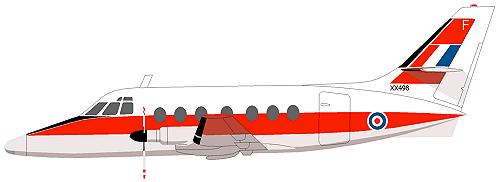Gallery No 18 - Jetstream
Aircraft - 2 Images
My thanks to Roger Dunn and the MOD for supplying these images.Wikipedia for text.
| On Her Majesty's Service
The first of the aircraft destined for the RAF flew on 13 April 1973, with all being delivered by early 1976. Initial deliveries went to the CFS at RAF Little Rissington, but the first FTS unit to be equipped was 5 FTS at RAF Oakington, near Cambridge which took six aircraft before a review concluded enough multi-engined pilots were in the 'system'. Consequently Oakington's Jetstreams were flown to RAF St Athan for storage, pending a re-assessment of Jetstream procurement. Eventually it was determined eleven aircraft would suffice the RAF's needs, so fourteen aircraft were modified to serve with the Royal Navy as the Jetstream T2 for observer training. The T2s differed mainly from the RAF version by the installation of MEL E190 weather and terrain-mapping radar in the nose radome. RAF training with the Jetstream re-commenced on 25 November 1976 with 3 FTS at RAF Leeming, where the Multi-engine Training Squadron (METS) was formed on 4 May 1977. The Jetstream's stay at Leeming was brief as 3 FTS moved south to RAF Finningley on 30 April 1979 to make way for reconstruction work in readiness for Tornado ADV operations. The eleven Jetstreams used by the RAF were mostly from the second batch produced, the original CFS and Oakington machines being converted for Navy use. In nearly thirty years of operations, the Jetstream's record has been mostly impeccable, with only one fatal accident (XX489 crashing on Portland Harbour in May 1989) and only one RAF aircraft involved in a major incident (XX477 written-off at Little Rissington on 1 November 1974). Certainly since its introduction at Leeming, all eleven have a perfect safety record and have amassed nearly 120,000 flying hours between them. Since the Jetstreams move to RAF Cranwell on 1 October 1995, the fleet has dwindled to six airworthy aircraft, and it's the aircraft's recent poor serviceability record, plus essential avionics upgrades required by 2007, that has led to its retirement a few years ahead of plan. As well as operating under CAA exemptions for the last few years, modifications to the engines for Health & Safety reasons were required and many of its technical faults were small but not easily corrected - microswitches were often failing, leading to an unserviceable aircraft for a minor part that would be difficult to get to. Unable to achieve the required 5,400 hours a year to complete all courses, this unreliability led to 45(R) Squadron contracting out some 'Short Course' (QFI and Instructor training) to Oxford Air Training at Kidlington, using the Seneca. Obviously not an ideal situation, an interim solution before MFTS takes hold has been found in the lease of seven Beech King Air 200s for the next five years, enabling the Jetstream to be retired - see Turn of the King, December 2003. With thanks to AirsceneUK. |
Some aircraft may appear identical but there are differences which will not be discernible from the image.
(Be patient with loading)
 |
45R Squadron |
 |
The Last Formation (AirsceneUK) |
(Be patient with loading)